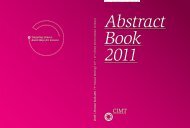Abstract Book 2010 - CIMT Annual Meeting
Abstract Book 2010 - CIMT Annual Meeting
Abstract Book 2010 - CIMT Annual Meeting
Create successful ePaper yourself
Turn your PDF publications into a flip-book with our unique Google optimized e-Paper software.
003 Altvater | Therapeutic vaccination<br />
Presentation of tumor-associated epitopes by activated human<br />
γδ T cells induces expansion of specific CD8+ T cells from<br />
naïve precursors<br />
Bianca Altvater 1 , Silke Landmeier 1 , Sibylle Pscherer 1 , Anna Hansmeier 1 , Barbara Savoldo 2 ,<br />
H. Juergens 1 , Claudia Rossig 1<br />
1 University Children´s Hospital Münster, Department of Pediatric Hematology and Oncology,<br />
Albert-Schweitzer-Str. 33, 48149 Münster<br />
2 Center for Cell and Gene Therapy, Baylor College of Medicine, Houston, TX, U.S.A<br />
Efficient antigen presentation is an important<br />
prerequisite for the induction of therapeutic T-cell<br />
immunity against viral and tumor antigens. In an<br />
Epstein Barr virus (EBV) model, we previously demonstrated<br />
that bisphosphonate-activated γδ T cells<br />
are potent stimulators of functional EBV-specific T<br />
cell responses in both normal donors and Hodgkin<br />
lymphoma patients. Here, we extended these observations<br />
by investigating the capacity of activated γδ<br />
T cells to induce primary T-cell responses against<br />
the tumor-associated, poorly immunogeneic antigens<br />
PRAME and STEAP-1 from the naive T-cell<br />
repertoire.<br />
Peripheral blood-derived γδ T cells were expanded<br />
from three individual HLA-A2 positive healthy<br />
donors by stimulation with the aminobisphosphonate<br />
zoledronic acid (1 µg/ml) in the presence of<br />
rhIL-2 (100 U/ml) and rhIL-15 (10 ng/ml). To investigate<br />
the ability of activated γδ T cells to stimulate<br />
expansion of PRAME- and STEAP-1 specific<br />
cytotoxic T cells (CTL) in vitro, purified autologous<br />
CD8+ T cells were cocultured with either dendritic<br />
cells (DCs) or activated γδ T cells pulsed with<br />
pools of HLA-A2 restricted peptides derived from<br />
either STEAP-1 or PRAME, followed by two stimulations<br />
with peptide-pulsed K-562 cells, genemodified<br />
to express human HLA-A2, CD80, CD40L,<br />
and OX40L (K-562-APCs). ELISPOT analysis demonstrated<br />
efficient and equivalent induction of<br />
specific CD8+ T-cell responses by both DCs and<br />
γδ T-APCs. Both types of CTLs had a predominant<br />
effector memory phenotype (CCR7-CD45R0+).<br />
Even though antigen-experienced precursor CTLs<br />
against the tumor-associated antigens are absent in<br />
the majority of healthy donors, these experiments<br />
do not formally prove that the expanded T cells are<br />
a consequence of T-cell priming. To demonstrate<br />
the origin of CTLs from antigen-naïve T cells, we<br />
performed additional coculture experiments using<br />
CD45RA+ T cells, purified from the CD8+ T-cell<br />
population by magnetic cell selection, as responder<br />
cells. Again, ELISPOT analysis after primary stimulation<br />
with PRAME peptide-pulsed autologous<br />
DCs or γδ T-APCs demonstrated specific and potent<br />
CTL reactivity against both pooled and individual<br />
PRAME peptides. Importantly, γδ T-APC induced<br />
CTLs were not inferior to those generated using the<br />
DC gold standard.<br />
Thus, γδ T cells represent a promising source of<br />
highly efficient professional APC for antigen-specific<br />
immunotherapy of cancer. In current experiments,<br />
we are establishing the capacity of γδ T<br />
cells endogenously expressing STEAP-1 or PRAME<br />
full-length antigen in inducing functional primary<br />
CTL responses.<br />
39



